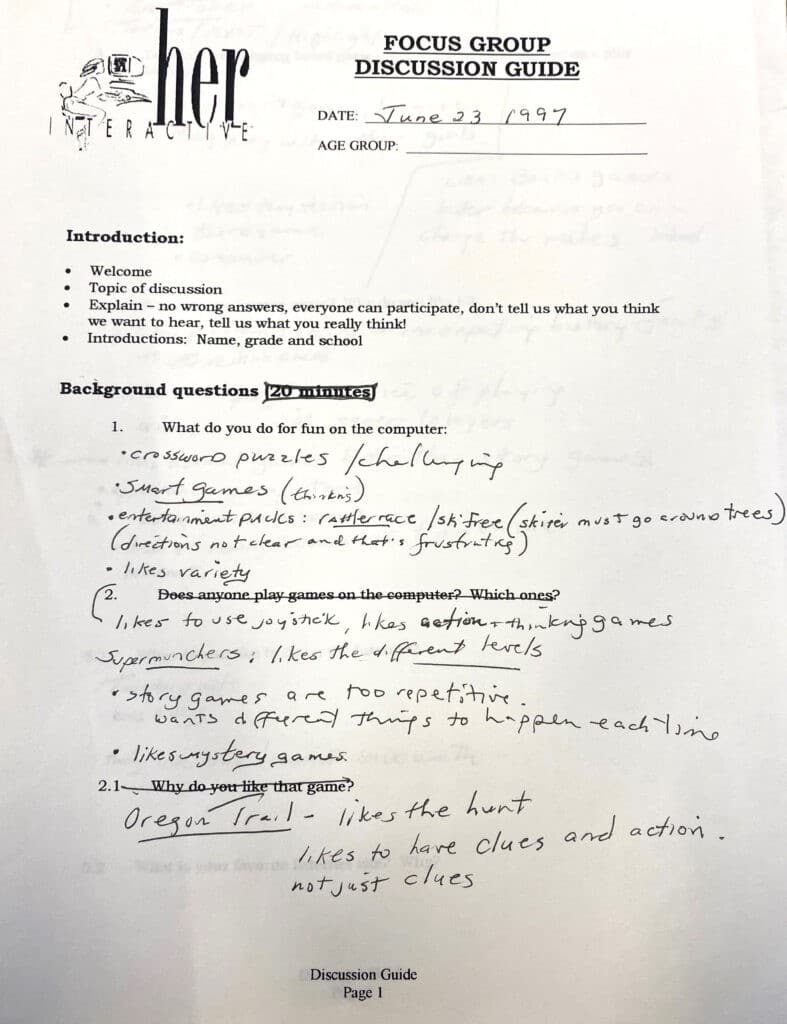The video game company Her Interactive adopted the slogan “For Girls Who Aren’t Afraid of a Mouse.” The firm’s fan letters and focus group collections informed my research on how video games are a technological construction of human expression. Her Interactive was a company focused on creating games based on the reception they received from their audience—girl gamers. They wanted to make video games based on the Nancy Drew series of novels more story driven so that girls would be drawn to explore the world of computer games.

Created in 1995, the company asked groups of girls what they wanted to actually play. The girls declared they wanted mystery, adventure, maybe even something a little scary at times. They wanted complex plots, with puzzles and challenges. Above all they did not want to be bored. When it came to how Nancy should look there where plenty of debates in the groups. Some thought she should have a scar, or maybe have different body types. They at least agreed she needed to update her style. The firm even asked the girls where they did their shopping and where they would be most likely to buy the game, as most video game stores catered almost exclusively to male gamers at the time. Throughout all these focus group documents, I uncovered information that showed how Her Interactive crafted their games for girls to enjoy.
However, not all the fan mail turned out to be from young girls. In one of the emails sent to Her Interactive a young gamer detailed why Nancy Drew became important to him. After the death of his mother, he was in a store searching for something to take his mind of the tragedy. He had some money that was left to him in her will and was looking for a book, a game, or really anything. Following the sound of his father snickering, the gamer came upon a section of the store devoted to games for girls. “What is this world coming to when they are trying to sell video games to girls?” his father asked. The gamer looked more closely at the titles on display until his eyes landed on a familiar name: Nancy Drew. Enraged by his father’s snide comments, he picked it up.
The moment he got home he rushed to install the game. The gamer would come to a moment in narrative of Nancy Drew: The Secret of the Old Clock (2005) when Nancy revealed that her own mother had passed away. It was then that the player wrote that he began “tear, then cry, then sob.” He described how he “finally had someone to connect to: Nancy Drew.” These interactive games helped him take his mind off a tragedy he was experiencing. The story connected him with characters that had also gone through loss. He also admits that the game made him realize that it did not matter if Nancy was a girl, she still had wits, brains, and attitude. It definitely showed him he did not have to be a girl to enjoy games that were targeted to girls. Heroines were just as interesting as heroes.

Her Interactive’s games had given so many girls a way to voice what they wanted and needed from video games. However, the company was also able to reach other players outside their core demographic and give them a narrative to connect with too. In my research on how the masculine gendering of video games is socially constructed through early advertisements in the industry’s history, this Her Interactive archive at The Strong demonstrated just how true that is. While these games were meant to be for young girls, young men were equally capable of enjoying them, providing they were willing to give the games a chance.
While at The Strong, I also spent time looking through the Carol Shaw collection, the Atari Coin-Op Division corporate records, and the LGBTQ Video Game Archive Collection. These archival resources aided me in tracking the gendering of video games as a masculine technology through historical media. Some advertisements went further than others to portray gaming as a manly activity. However, developers like Carol Shaw, the woman behind games such as 3D Tic-Tac-Toe (1980), Video Checkers (1980), River Raid (1982), and Happy Trails (1983), have proven that this aura of masculine exclusivity was clearly a social construction. The Strong was immensely valuable to enabling me read through these collections, as my master’s thesis, “Not Damsels in Distress: Women and the Video Game Industry,” would be incomplete without this information.
Written by Abigail Pucik, 2022 Strong Research Fellow, Arkansas State University, Jonesboro, Arkansas


